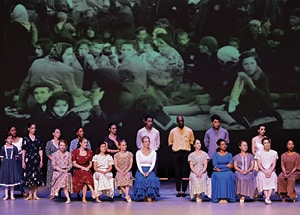Elbert Watson Dance Company interacts with the audience.
Is the suffering of others our own?
How do we make emotions explicit and use them positively to teach?
Why is it so difficult to accept certain facts?
How can history be controversial?
These were just a few of an abundance of framing questions that educators considered—and truly wrestled with—during the 14th Biennial Educators’ Conference organized by the Holocaust Commission of the United Jewish Federation of Tidewater.
The title of the conference, Teaching Difficult History: How Our Past Informs Our Present, captured the serious and daring nature of the lectures and interactive workshops. Approximately 70 educators attended the two-day conference, which included an artistic performance, a full day of presentations on the campus of Norfolk Academy, and a trip to the Virginia Holocaust Museum in Richmond.
“With everything going on in our world today, the Commission really wanted to give educators new tools to make classroom discussions about highly charged topics easier. We want teachers in the classroom who can lead students through challenging material, and not shy away from it,” says Elena Baum, Commission director.
This year’s conference opened on Tuesday, July 30, with an Evening with the Arts, featuring an original, seven-part dance about the Holocaust, created by Elbert Watson, dance master at Norfolk Academy, and a former principal dancer with Alvin Ailey American Dance Theater. The piece, I Flutter My Wings, But I Can’t Get Away performed by the Elbert Watson Dance Company, kept the audience riveted with its gut-wrenching depictions of Nazi horror.

Scene from I Flutter My Wings, But I Can’t Get Away.
The arts evening opened with keynote remarks by Elizabeth Lodal, a member of the Virginia State Board of Education and former principal of several public schools in northern Virginia. “Antisemitism and racism are two sides of the same coin of bigotry,” she noted. “We are all created in God’s image and worthy of being treated with respect.”
Sponsored by Bank of America, the conference opened with a speech by Christonya Brown, coordinator of history and social science for the Virginia Department of Education. Her speech was followed by a presentation from Maia Sheppard, a professor at George Washington University, who spoke about the impact of students’ emotions in a classroom environment. She offered insights about creating a purposeful, relational, and responsive classroom community.
Monuments and sites memorializing the Confederacy were the focus of a presentation by Jeremy Stoddard, associate professor at the University of Wisconsin -Madison. He opened with a complex question: What makes an historical issue or event controversial? In his lecture, he unpacked the ways that historical events are impacted by interpretation. In some cases, textbooks provide “sanitized” histories that reinforce national themes, while ignoring the actual historical record and academic research.
He engaged teachers in small group discussions about sites of memory involving the Civil War, such as monuments to Confederate generals. “What is truly an open question and what is closed on this controversy?” he asked. “How might you frame inquiry for your students around this controversy?”
The conference also offered workshops about using literature to teach the history of the Holocaust. Stoddard gave a second presentation about the use of films, and Jeff Eargle, assistant clinical professor in Secondary Humanities Education at the University of South Carolina, spoke about the power of graphic novels to teach challenging historical topics in a way that engages students at an emotional level, so the learning resonates.
The educators took a bus to Richmond for the conference’s final day, where they toured the Virginia Holocaust Museum and heard a lecture by Charles Sydnor, former executive director of the museum and currently the museum’s senior historian.
As teachers received professional education hours for the conference, there was not a moment wasted. On the bus ride, they viewed several films about Father Patrick Desbois and his organization, Yahad in Unum. (Father Desbois spoke to the community in January 2019 at the Sandler Center.) This prepared them to tour Yahad in Unum’s traveling exhibit at the VHM about the Holocaust by Bullets.
Teachers also viewed a What We Carry film while traveling I-64, and learned about that program of the Holocaust Commission available to them and their students.
In addition to the traveling exhibit, once at the museum the participants heard a fact-filled talk from VHM Senior Historian, Dr. Charles Sydnor, and had a tour of the permanent exhibit. Many came home and began working on field trip requests to take their students to the museum in the coming year.
Conference co-chairs were Gail Flax, Lisa Cohn, and Wendy Juren Aurebach.
Esther Diskin

